Abstract
Helicobacter pylori has been shown, along with other Helicobacter species to produce effector molecules that induce substantial physiological changes on acid and pepsin secretion. The effects are clinically evident, and long-term achlorhydria may be a risk factor for gastric cancer. Further identification and characterization of the factors may lead to additional understanding of gastric physiology.
Full text
PDF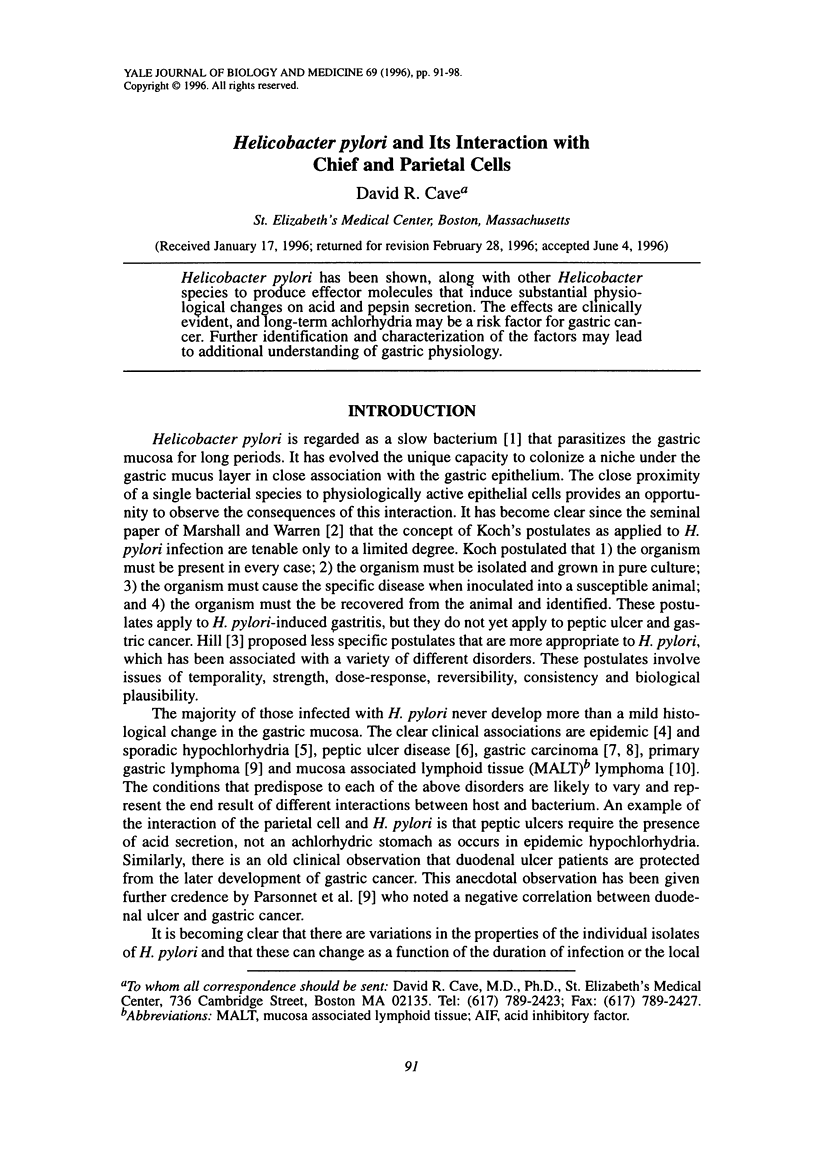
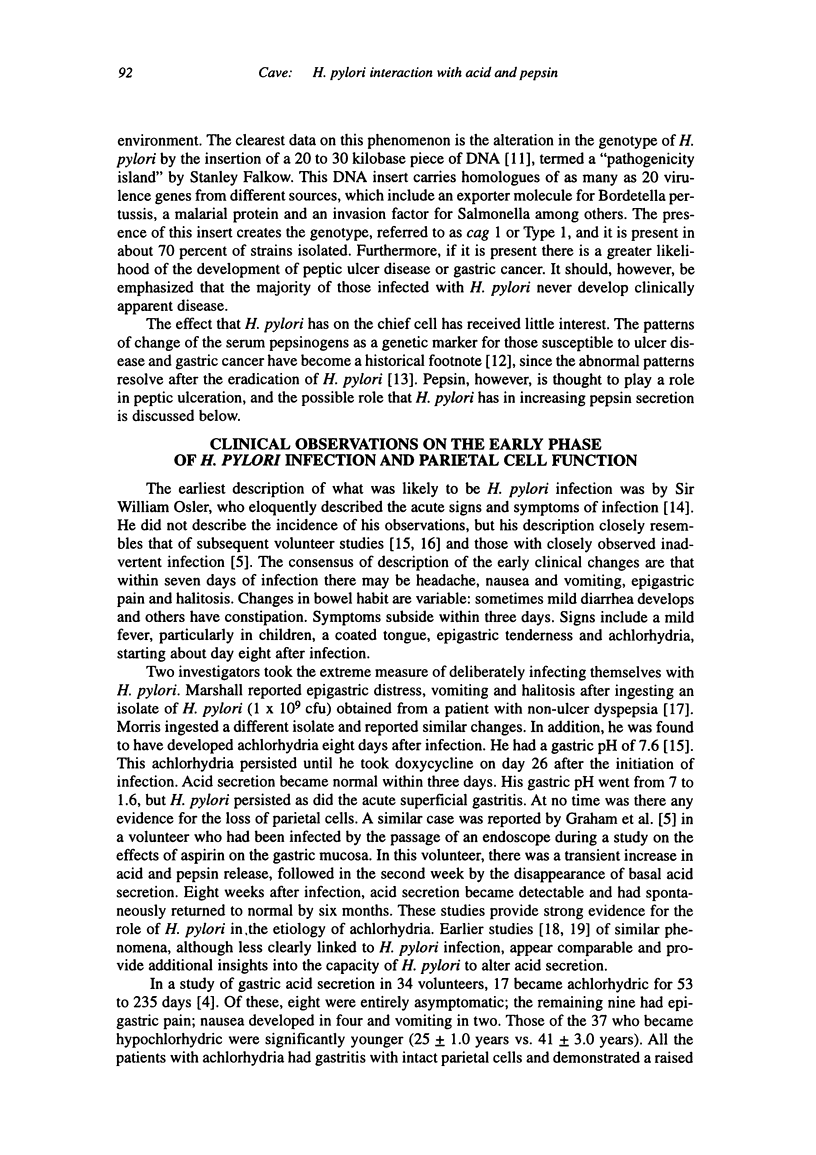

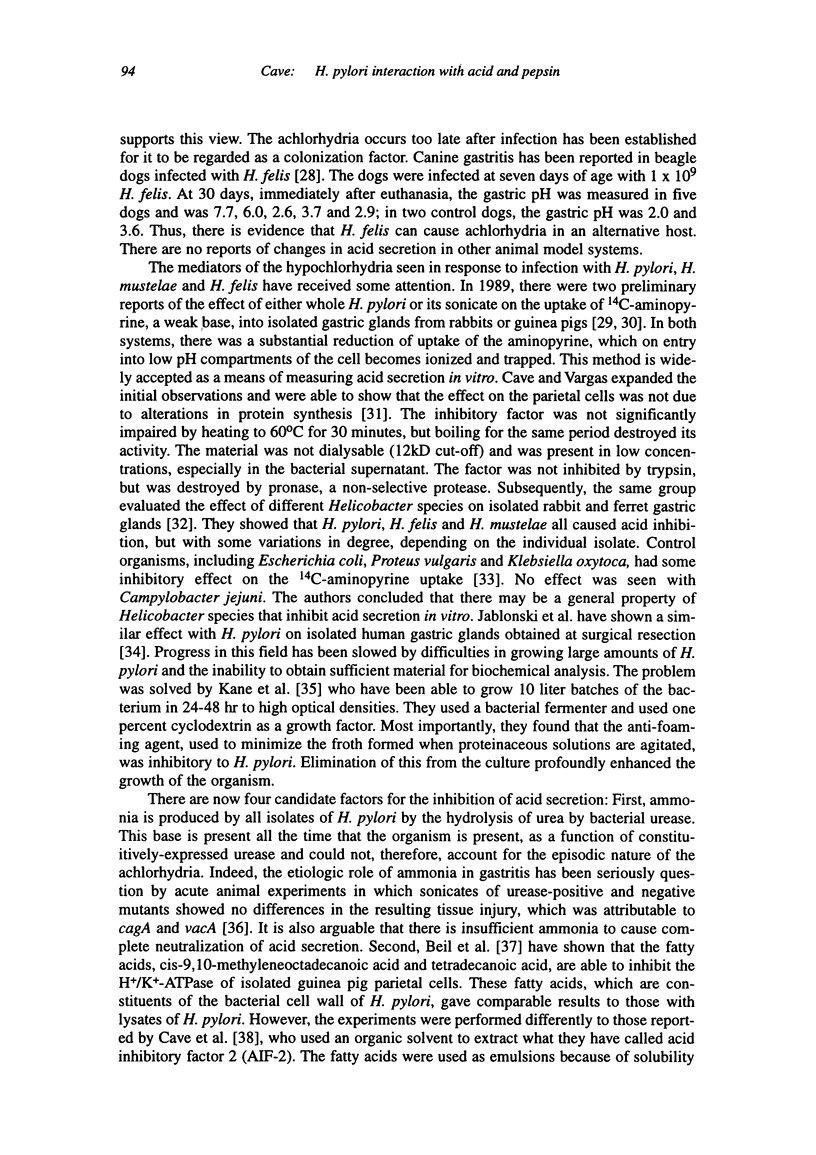
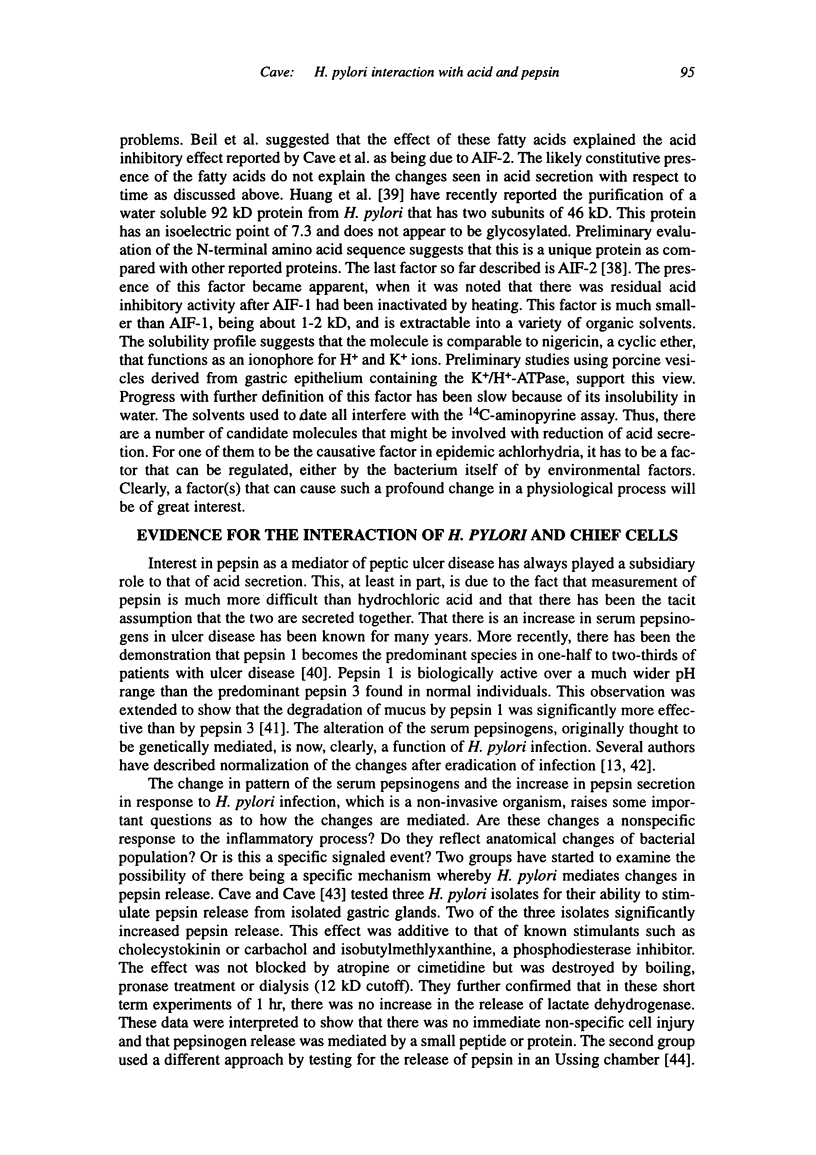
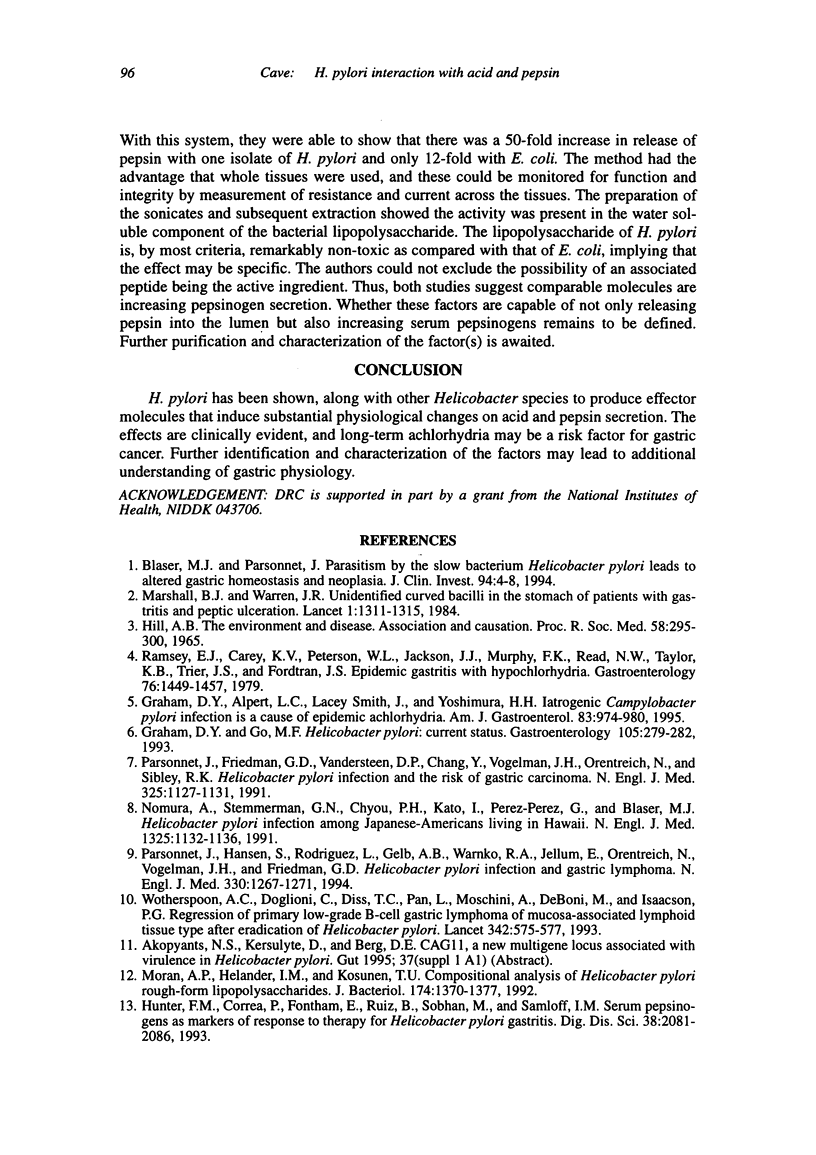
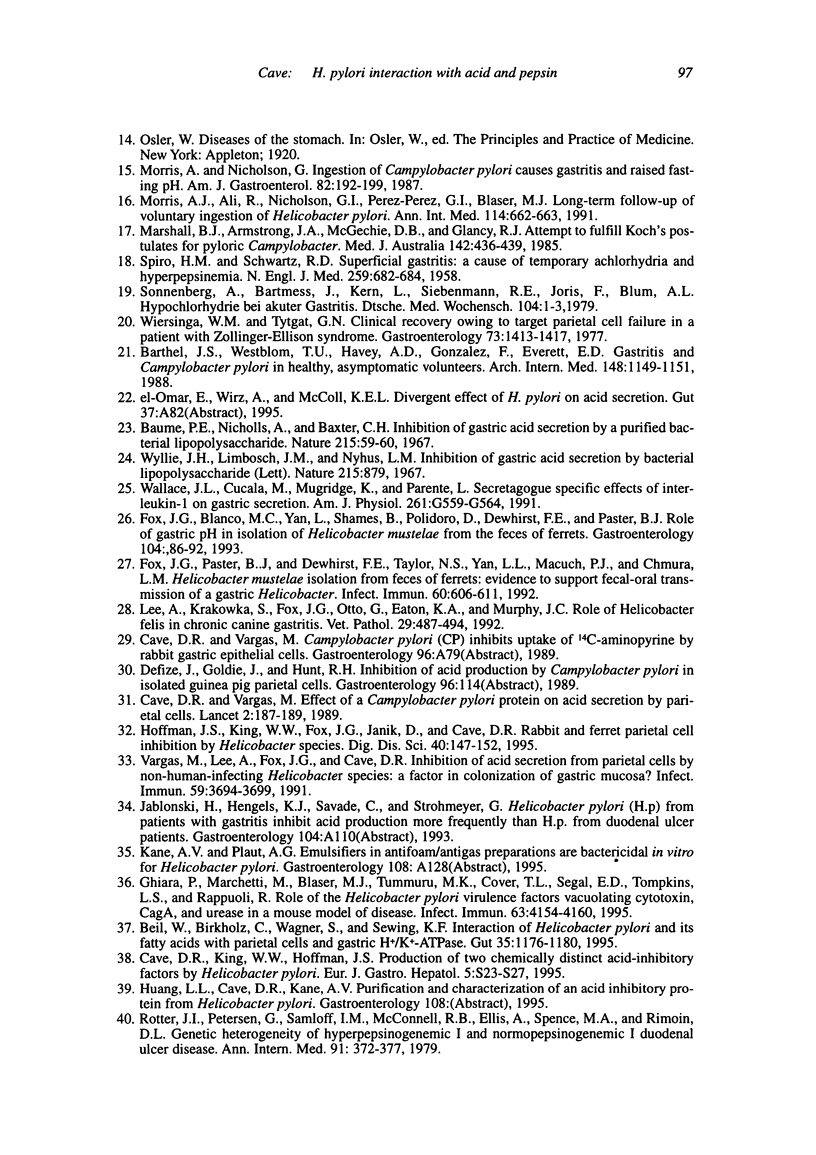
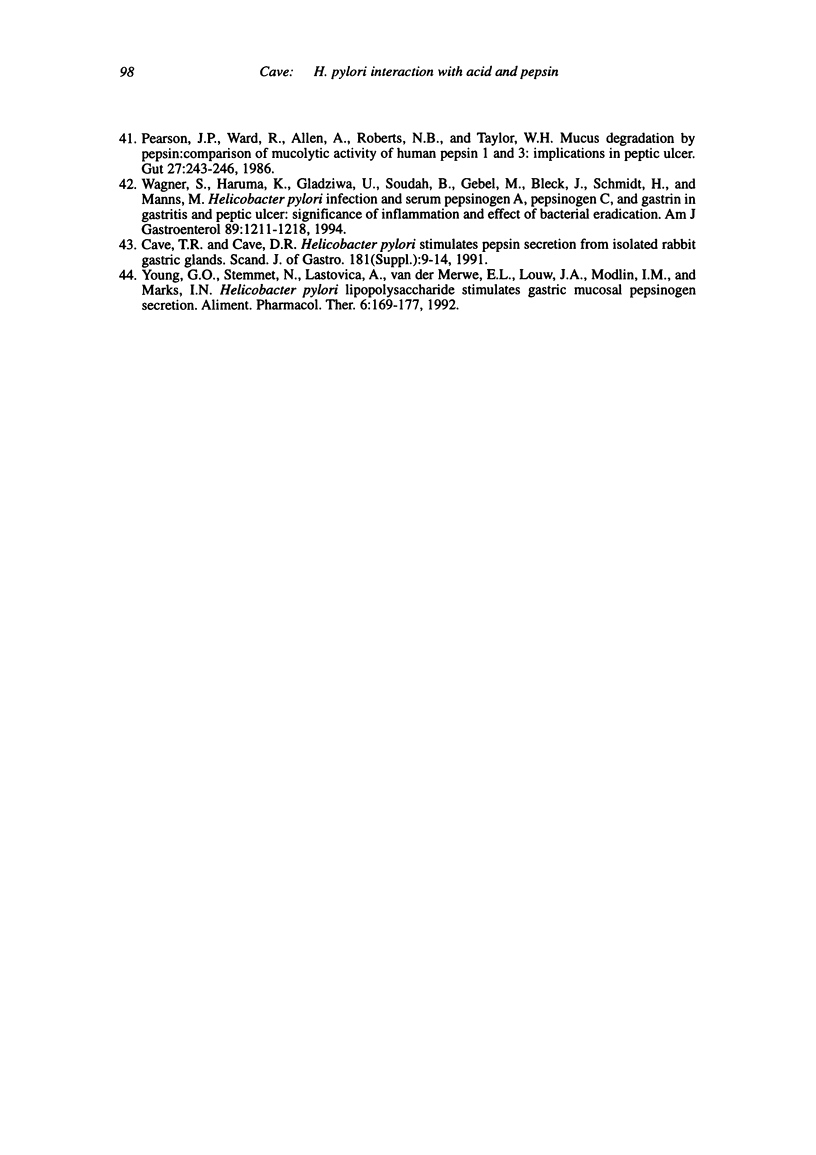
Selected References
These references are in PubMed. This may not be the complete list of references from this article.
- Barthel J. S., Westblom T. U., Havey A. D., Gonzalez F., Everett E. D. Gastritis and Campylobacter pylori in healthy, asymptomatic volunteers. Arch Intern Med. 1988 May;148(5):1149–1151. [PubMed] [Google Scholar]
- Baume P. E., Nicholls A., Baxter C. H. Inhibition of gastric acid secretion by a purified bacterial lipopolysaccharide. Nature. 1967 Jul 1;215(5096):59–60. doi: 10.1038/215059a0. [DOI] [PubMed] [Google Scholar]
- Beil W., Birkholz C., Wagner S., Sewing K. F. Interaction of Helicobacter pylori and its fatty acids with parietal cells and gastric H+/K(+)-ATPase. Gut. 1994 Sep;35(9):1176–1180. doi: 10.1136/gut.35.9.1176. [DOI] [PMC free article] [PubMed] [Google Scholar]
- Blaser M. J., Parsonnet J. Parasitism by the "slow" bacterium Helicobacter pylori leads to altered gastric homeostasis and neoplasia. J Clin Invest. 1994 Jul;94(1):4–8. doi: 10.1172/JCI117336. [DOI] [PMC free article] [PubMed] [Google Scholar]
- Cave D. R., Vargas M. Effect of a Campylobacter pylori protein on acid secretion by parietal cells. Lancet. 1989 Jul 22;2(8656):187–189. doi: 10.1016/s0140-6736(89)90372-3. [DOI] [PubMed] [Google Scholar]
- Cave T. R., Cave D. R. Helicobacter pylori stimulates pepsin secretion from isolated rabbit gastric glands. Scand J Gastroenterol Suppl. 1991;181:9–14. doi: 10.3109/00365529109093202. [DOI] [PubMed] [Google Scholar]
- Fox J. G., Blanco M. C., Yan L., Shames B., Polidoro D., Dewhirst F. E., Paster B. J. Role of gastric pH in isolation of Helicobacter mustelae from the feces of ferrets. Gastroenterology. 1993 Jan;104(1):86–92. doi: 10.1016/0016-5085(93)90839-5. [DOI] [PubMed] [Google Scholar]
- Fox J. G., Paster B. J., Dewhirst F. E., Taylor N. S., Yan L. L., Macuch P. J., Chmura L. M. Helicobacter mustelae isolation from feces of ferrets: evidence to support fecal-oral transmission of a gastric Helicobacter. Infect Immun. 1992 Feb;60(2):606–611. doi: 10.1128/iai.60.2.606-611.1992. [DOI] [PMC free article] [PubMed] [Google Scholar]
- Ghiara P., Marchetti M., Blaser M. J., Tummuru M. K., Cover T. L., Segal E. D., Tompkins L. S., Rappuoli R. Role of the Helicobacter pylori virulence factors vacuolating cytotoxin, CagA, and urease in a mouse model of disease. Infect Immun. 1995 Oct;63(10):4154–4160. doi: 10.1128/iai.63.10.4154-4160.1995. [DOI] [PMC free article] [PubMed] [Google Scholar]
- Graham D. Y., Alpert L. C., Smith J. L., Yoshimura H. H. Iatrogenic Campylobacter pylori infection is a cause of epidemic achlorhydria. Am J Gastroenterol. 1988 Sep;83(9):974–980. [PubMed] [Google Scholar]
- Graham D. Y., Go M. F. Helicobacter pylori: current status. Gastroenterology. 1993 Jul;105(1):279–282. doi: 10.1016/0016-5085(93)90038-e. [DOI] [PubMed] [Google Scholar]
- HILL A. B. THE ENVIRONMENT AND DISEASE: ASSOCIATION OR CAUSATION? Proc R Soc Med. 1965 May;58:295–300. [PMC free article] [PubMed] [Google Scholar]
- Hoffman J. S., King W. W., Fox J. G., Janik D., Cave D. R. Rabbit and ferret parietal cell inhibition by Helicobacter species. Dig Dis Sci. 1995 Jan;40(1):147–152. doi: 10.1007/BF02063958. [DOI] [PubMed] [Google Scholar]
- Hunter F. M., Correa P., Fontham E., Ruiz B., Sobhan M., Samloff I. M. Serum pepsinogens as markers of response to therapy for Helicobacter pylori gastritis. Dig Dis Sci. 1993 Nov;38(11):2081–2086. doi: 10.1007/BF01297088. [DOI] [PubMed] [Google Scholar]
- Lee A., Krakowka S., Fox J. G., Otto G., Eaton K. A., Murphy J. C. Role of Helicobacter felis in chronic canine gastritis. Vet Pathol. 1992 Nov;29(6):487–494. doi: 10.1177/030098589202900601. [DOI] [PubMed] [Google Scholar]
- Marshall B. J., Armstrong J. A., McGechie D. B., Glancy R. J. Attempt to fulfil Koch's postulates for pyloric Campylobacter. Med J Aust. 1985 Apr 15;142(8):436–439. doi: 10.5694/j.1326-5377.1985.tb113443.x. [DOI] [PubMed] [Google Scholar]
- Marshall B. J., Warren J. R. Unidentified curved bacilli in the stomach of patients with gastritis and peptic ulceration. Lancet. 1984 Jun 16;1(8390):1311–1315. doi: 10.1016/s0140-6736(84)91816-6. [DOI] [PubMed] [Google Scholar]
- Moran A. P., Helander I. M., Kosunen T. U. Compositional analysis of Helicobacter pylori rough-form lipopolysaccharides. J Bacteriol. 1992 Feb;174(4):1370–1377. doi: 10.1128/jb.174.4.1370-1377.1992. [DOI] [PMC free article] [PubMed] [Google Scholar]
- Morris A. J., Ali M. R., Nicholson G. I., Perez-Perez G. I., Blaser M. J. Long-term follow-up of voluntary ingestion of Helicobacter pylori. Ann Intern Med. 1991 Apr 15;114(8):662–663. doi: 10.7326/0003-4819-114-8-662. [DOI] [PubMed] [Google Scholar]
- Morris A., Nicholson G. Ingestion of Campylobacter pyloridis causes gastritis and raised fasting gastric pH. Am J Gastroenterol. 1987 Mar;82(3):192–199. [PubMed] [Google Scholar]
- Nomura A., Stemmermann G. N., Chyou P. H., Kato I., Perez-Perez G. I., Blaser M. J. Helicobacter pylori infection and gastric carcinoma among Japanese Americans in Hawaii. N Engl J Med. 1991 Oct 17;325(16):1132–1136. doi: 10.1056/NEJM199110173251604. [DOI] [PubMed] [Google Scholar]
- Parsonnet J., Friedman G. D., Vandersteen D. P., Chang Y., Vogelman J. H., Orentreich N., Sibley R. K. Helicobacter pylori infection and the risk of gastric carcinoma. N Engl J Med. 1991 Oct 17;325(16):1127–1131. doi: 10.1056/NEJM199110173251603. [DOI] [PubMed] [Google Scholar]
- Parsonnet J., Hansen S., Rodriguez L., Gelb A. B., Warnke R. A., Jellum E., Orentreich N., Vogelman J. H., Friedman G. D. Helicobacter pylori infection and gastric lymphoma. N Engl J Med. 1994 May 5;330(18):1267–1271. doi: 10.1056/NEJM199405053301803. [DOI] [PubMed] [Google Scholar]
- Pearson J. P., Ward R., Allen A., Roberts N. B., Taylor W. H. Mucus degradation by pepsin: comparison of mucolytic activity of human pepsin 1 and pepsin 3: implications in peptic ulceration. Gut. 1986 Mar;27(3):243–248. doi: 10.1136/gut.27.3.243. [DOI] [PMC free article] [PubMed] [Google Scholar]
- Ramsey E. J., Carey K. V., Peterson W. L., Jackson J. J., Murphy F. K., Read N. W., Taylor K. B., Trier J. S., Fordtran J. S. Epidemic gastritis with hypochlorhydria. Gastroenterology. 1979 Jun;76(6):1449–1457. [PubMed] [Google Scholar]
- Rotter J. I., Petersen G., Samloff I. M., McConnell R. B., Ellis A., Spence M. A., Rimoin D. L. Genetic heterogeneity of hyperpepsinogenemic I and normopepsinogenemic I duodenal ulcer disease. Ann Intern Med. 1979 Sep;91(3):372–377. doi: 10.7326/0003-4819-91-3-372. [DOI] [PubMed] [Google Scholar]
- SPIRO H. M., SCHWARTZ R. D. Superficial gastritis; a cause of temporary achlorhydria and hyperpepsinemia. N Engl J Med. 1958 Oct 2;259(14):682–684. doi: 10.1056/NEJM195810022591406. [DOI] [PubMed] [Google Scholar]
- Vargas M., Lee A., Fox J. G., Cave D. R. Inhibition of acid secretion from parietal cells by non-human-infecting Helicobacter species: a factor in colonization of gastric mucosa? Infect Immun. 1991 Oct;59(10):3694–3699. doi: 10.1128/iai.59.10.3694-3699.1991. [DOI] [PMC free article] [PubMed] [Google Scholar]
- Wagner S., Haruma K., Gladziwa U., Soudah B., Gebel M., Bleck J., Schmidt H., Manns M. Helicobacter pylori infection and serum pepsinogen A, pepsinogen C, and gastrin in gastritis and peptic ulcer: significance of inflammation and effect of bacterial eradication. Am J Gastroenterol. 1994 Aug;89(8):1211–1218. [PubMed] [Google Scholar]
- Wallace J. L., Cucala M., Mugridge K., Parente L. Secretagogue-specific effects of interleukin-1 on gastric acid secretion. Am J Physiol. 1991 Oct;261(4 Pt 1):G559–G564. doi: 10.1152/ajpgi.1991.261.4.G559. [DOI] [PubMed] [Google Scholar]
- Wiersinga W. M., Tytgat G. N. Clinical recovery owing to target parietal cell failure in a patient with Zollinger-Ellison syndrome. Gastroenterology. 1977 Dec;73(6):1413–1417. [PubMed] [Google Scholar]
- Wotherspoon A. C., Doglioni C., Diss T. C., Pan L., Moschini A., de Boni M., Isaacson P. G. Regression of primary low-grade B-cell gastric lymphoma of mucosa-associated lymphoid tissue type after eradication of Helicobacter pylori. Lancet. 1993 Sep 4;342(8871):575–577. doi: 10.1016/0140-6736(93)91409-f. [DOI] [PubMed] [Google Scholar]
- Wyllie J. H., Limbosch J. M., Nyhus L. M. Inhibition of gastric acid secretion by bacterial lipopolysaccharide. Nature. 1967 Aug 19;215(5103):879–879. doi: 10.1038/215879a0. [DOI] [PubMed] [Google Scholar]
- Young G. O., Stemmet N., Lastovica A., van der Merwe E. L., Louw J. A., Modlin I. M., Marks I. N. Helicobacter pylori lipopolysaccharide stimulates gastric mucosal pepsinogen secretion. Aliment Pharmacol Ther. 1992 Apr;6(2):169–177. doi: 10.1111/j.1365-2036.1992.tb00260.x. [DOI] [PubMed] [Google Scholar]


